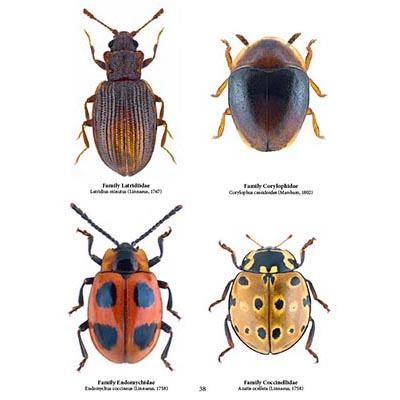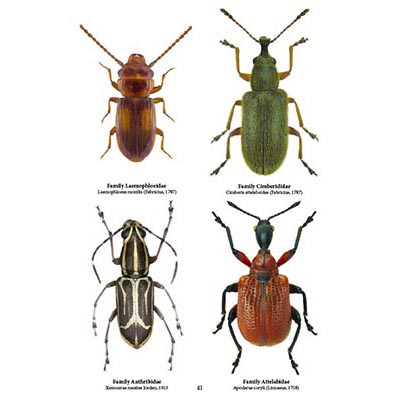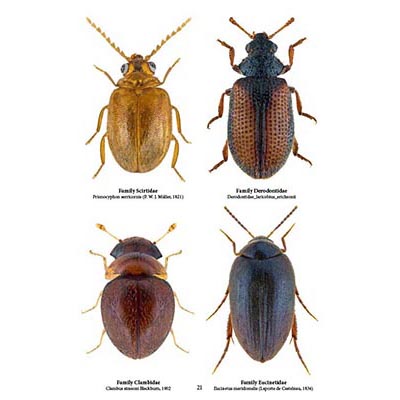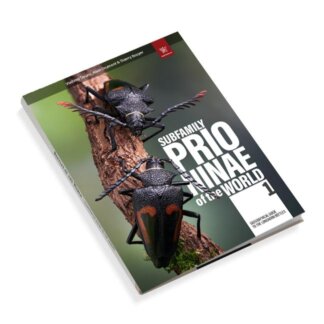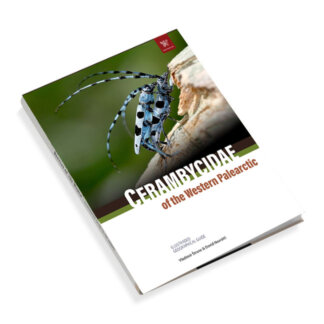Coleoptera is one of the largest insect orders, characterized by its enormous diversity and wide distribution in all ecosystems. It is also known by the name beetles, which is used to refer to members of this order. This group of insects includes over 350,000 described species, which is more than one-third of all known insects.
Book novelties:
Prioninae of the World I.
Cerambycidae of the Western Paleartic I.
Coleoptera Beetles, Insect
One of the interesting features of the Coleoptera are their tough trusses, which are characteristic of this order. The trusses are the upper wings of the beetle that serve as a protective sheath for the soft and intricately folded hind wings. These trusses are often very attractive and colourful.
Books about Beetles
Unique pictorial atlases for identifying Beetles:
(2020) Tiger Beetles of the World, Cicindelidae, Illustrated guide to the genera
(2023) Tiger Beetles of Africa, Cicindelidae, Geographical guide to the family Cicindelidae
(2024) Tiger Beetles of Orient, Cicindelidae, Geographical guide to the family Cicindelidae
(2022) Ground Beetles of Africa, Afrotropical Region
(2022) Jewel Beetles of the World, Buprestidae, Illustrated guide to the Superfamily Buprestoidea
(2008) The Prionids of the World, Prioninae, Illustrated catalogue of the Beetles
(2010) The Prionids of the Neotropical region, Prioninae, Illustrated catalogue of the Beetles
Coleoptera: The Extraordinary World of Beetles
Beetles represent one of the most successful and diverse groups of organisms on Earth, constituting approximately 25% of all known animal species with over 300,000 documented species. Their evolutionary history spans hundreds of millions of years, demonstrating remarkable adaptability and ecological significance. This report explores the taxonomy, morphology, evolution, and ecological importance of beetles (order Coleoptera), highlighting their remarkable diversity and their crucial roles in ecosystems worldwide.
Taxonomic Classification and Evolutionary Relationships, Insect
Coleoptera belongs to the superorder Coleopterida, which also includes the order Strepsiptera. This superorder is established as the sister group to Neuropterida based on both phylogenetic analysis of DNA sequence data and supporting morphological evidence. Within the insect class, Coleoptera is situated within several nested clades, including Holometabola, Aparaglossata, and Neuropteroidea.
Suborders and Phylogenetic Structure
Modern phylogenetic analyses have provided strong support for the relationships among the four suborders of Coleoptera. The subordinal relationships are robustly supported as Polyphaga (Adephaga (Archostemata, Myxophaga)). This means that Polyphaga, which contains the vast majority of beetle families and species, is the sister group to a clade containing the other three suborders, with Adephaga being the sister group to a clade comprising Archostemata and Myxophaga.
The series and superfamilies within Polyphaga have been found to be mostly monophyletic, providing a foundation for natural classification. Recent molecular studies have revealed some novel relationships, such as the placement of the species-poor Nosodendridae as sister to Staphyliniformia, Bostrichiformia, and Cucujiformia.
Evolutionary Timeline
The evolutionary history of beetles extends deep into geological time. Divergence time analyses suggest that the crown group of extant beetles originated approximately 297 million years ago (Mya) during the earliest Permian period. This contradicts some earlier studies that proposed an even older origin in the mid-Carboniferous (approximately 333 Mya).
Notably, about 64% of beetle families are estimated to have originated during the Cretaceous period. This timeframe coincides with the rise and diversification of flowering plants (angiosperms), suggesting a potential evolutionary relationship between these two groups. Fossil records indicate that beetles are the oldest known pollinators of flowering plants, with evidence showing they coexisted with dinosaurs during the Mesozoic Era, roughly 200 million years ago.
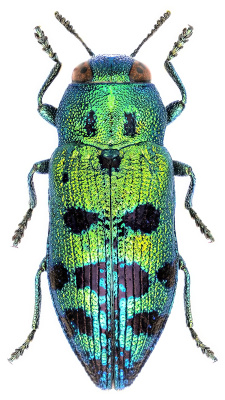

Beetle Morphology
Beetles possess a distinctive and relatively uniform morphological structure that distinguishes them from other insect orders. Their scientific name, Coleoptera, translates to “sheathed wings,” referring to their characteristic hardened forewings (elytra) that protect the membranous hindwings used for flight.
Head and Mouthparts
The beetle head is flexibly attached to the thorax by the cervix and consists of a rigid capsule containing several important structures. The head houses the eyes (oculi), antennae, and mouthparts. The sides of the head feature structures known as the cheeks (genae) located below or in front of the eyes, while the regions behind the eyes are called temples (tempus).
The upper side of the head is divided into the forehead (frons) between the eyes and the vertex behind it. The front part of the head is the clypeus, often separated from the rest of the head by a rigid frontoclypeal suture. Attached to the clypeus is the upper lip (labrum), which is separated by the somewhat flexible clypeolabral suture. In some beetle species, the labrum is concealed by the clypeus when viewed from above.
The mouthparts of beetles show adaptations related to their feeding habits. Herbivorous species have mandibles designed for biting and chewing plant material, while predatory beetles typically possess edged and pointed mandibles for capturing and subduing prey. Some species exhibit modified mouthparts not primarily used for feeding; for example, male stag beetles (Lucanus cervus) have enlarged, antler-like mandibles used in combat with other males.
The lower front of the head contains the maxillae with their segmented palps (palpus maxillaris) that are usually visible from above. The labium or lower lip is a fused structure comprising several parts including the submentum, mentum, and glossa. Coleoptera Beetles, Insect
Carpet Beetles, Dermestidae
Diversity and Evolutionary Success
Beetles represent the most diverse and species-rich group of insects, accounting for approximately 40 percent of all known insects and roughly 25 percent of all known animals on Earth. With over 300,000 described species, they exhibit remarkable diversity in form, size, and ecological roles.
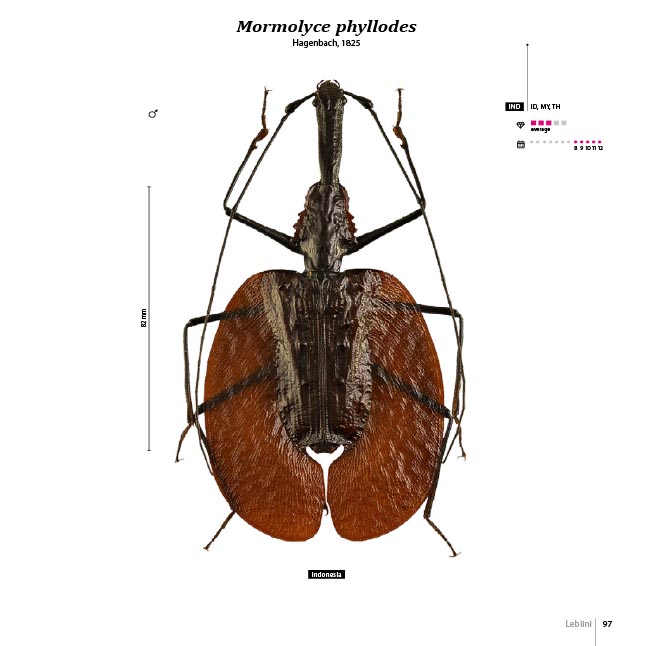
Coleoptera Beetles
Factors Driving Diversification
The extraordinary diversity of beetles can be attributed to several factors. Their evolutionary history began in the Permian and included a long period of steady diversification. Beetle lineages demonstrated high survival rates over time, enabling their diversification to enter an “exponential” phase during the late Jurassic period.
A significant driver of beetle diversification appears to be their relationship with flowering plants. Most herbivorous beetle families experienced a substantial increase in diversification rate during the Cretaceous period, suggesting that the rise of angiosperms during this time served as an “evolutionary impetus” for the hyperdiversity of plant-eating beetles. Although beetle diversification began before flowering plants dominated the landscape, the explosive radiation of angiosperms provided new ecological opportunities that further accelerated beetle speciation.
Life Cycle and Development
Beetles undergo complete metamorphosis (holometabolous development), comprising four distinct life stages: egg, larva, pupa, and adult.
Developmental Stages
The larval stage typically includes several instars (developmental stages between successive molts) before the insect enters the pupal stage, where it transforms into the winged adult form. The duration of the life cycle varies considerably among species. Some wood-boring beetles and scarab beetles may take 2-5 years or more to complete their development, while other species can produce several generations each year.
Feeding habits can differ markedly between life stages in some beetle groups. Lady beetles, for instance, maintain similar feeding behaviors as both larvae and adults, typically preying on other insects. In contrast, other beetles demonstrate completely different ecological roles across life stages. Blister beetle larvae, for example, are parasitic on soil-dwelling insects, while the adults exhibit different feeding behaviors.
Ecological Importance
Despite their reputation as agricultural pests, beetles play crucial and diverse roles in ecosystems worldwide.
Beneficial Ecological Roles
Many beetle species provide important ecosystem services as predators of pest insects. Lady beetles and predaceous ground beetles are considered helpful garden companions due to their pest-control services. Other beetles, including soldier beetles, longhorned beetles, sap beetles, and checkered beetles, contribute to pollination in gardens and natural habitats.
Beetles also serve as decomposers, breaking down dead plant and animal matter and returning nutrients to the soil. Their activities in this regard are essential to nutrient cycling in many ecosystems. Additionally, beetles constitute an important food source for numerous vertebrate and invertebrate predators, forming crucial links in food webs.
Conclusion Coleoptera Beetles
Beetles represent one of nature’s great success stories, demonstrating remarkable evolutionary adaptability and ecological versatility. Their extraordinary diversity—comprising approximately one-quarter of all known animal species—reflects their successful exploitation of countless ecological niches over hundreds of millions of years of evolution.
The long evolutionary history of Coleoptera, dating back to the Permian period, provided the foundation for their diversification. Their relationship with flowering plants appears to have been particularly significant, with the rise of angiosperms in the Cretaceous period coinciding with accelerated diversification among herbivorous beetle families.
Beyond their impressive diversity, beetles play essential roles in ecosystem functioning as predators, pollinators, decomposers, and food sources for other organisms. Their ecological significance extends from agricultural systems to natural habitats worldwide.
As ongoing research continues to illuminate the complex evolutionary relationships among beetle lineages and their ecological interactions, our understanding of this remarkable insect order will continue to deepen, highlighting the extraordinary biological success story that Coleoptera represents.

